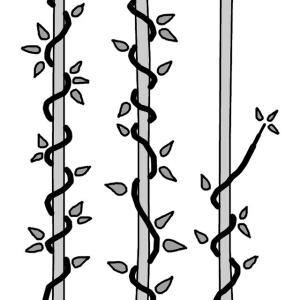The term vertical garden refers to any kind of construction and support structure for growing plants in an upwards-directed, vertical way and thereby efficiently and productively making use of the existing space for food or other kind of plant production. A huge variety of different designs and concepts are available including greywater towers, green walls or living walls. The reuse of different composts (e.g. compost, vermicompost or terra preta) from household wastes and reclaimed water (e.g. greywater) or urine can be considered in vertical gardening allowing to enhance food production and to close the nutrient and water cycle at a local level.
| Entradas | Salidas |
|---|---|
Treated Water, Food Products |
Vertical gardening aims to advance the productivity levels of urban and sub-urban agricultural production sites where most often available space is the biggest agricultural limitation. Plenty of different design solutions are available. The design of vertical garden (sometimes also called green walls) depends on the available material, space and local preferences as well as on the creativity and imagination of the users. Crops that can be grown comprise food crops (vegetables, fruits, herbs) and non-food crops (e.g. ornamental plants, medical plants). As a growing media soil, compost, vermicompost, terra preta compost, acrylic material as well as aquaponic and aeroponic solutions can be used. The crops can be grown in sacks, bags, flowerpots and all kinds of available receptacles like bins, cans, tins, bottles, tanks or boxes. They can be placed on yet unused places like on the roof of houses, balconies, on the top of walls or just hung up. Where space is available, earth beds of larger surface may even be installed, but require some expert design to control water drainage and infiltration.
Further vertical garden solutions that allow for a good utilisation of available space are cultivation arches, greywater towers or cultivation bags (see pictures below).

Other systems like cultivation umbrellas, cultivation bangles or some kind of cultivation that have also been proven useful (see picture below).
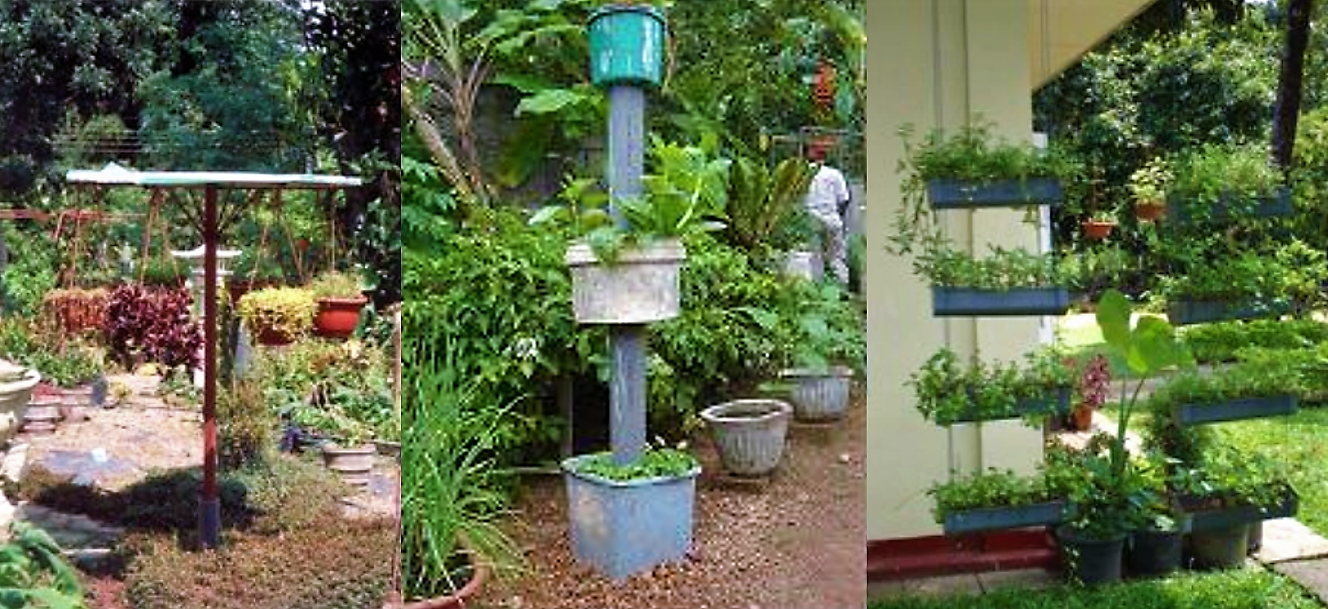
A variety of different substructures like cultivation ladders, pyramids or racks can be designed and constructed to grow plants vertically (see pictures below).

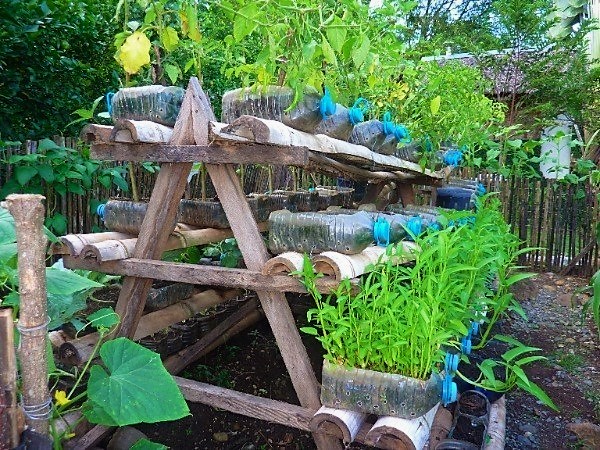
Walls, murals and exterior walls of houses are also often used as a vertical gardening alternative either just as beautification of the wall or to grow vegetables and other crops along the wall. Vertical gardens also have a positive effect on the house climate (keeping the walls cool in summer). Walls can be used easily without big additional construction work. Either the wall will be modified with additional bricks or holders can be used for growing plants on the surface of the wall (see pictures below). In Botswana for instance, Gus Nilsson, a Swedish horticulturist has developed a system of intensive horticulture for dry tropical areas, based on walls with built-in containers (WINBLAD / SIMPSON-HERBERT 2004). Plants should be selected according to the orientation of the wall. Walls directed North will have different characteristics with regard to exposure to the sun, wind and rain then those directed South.
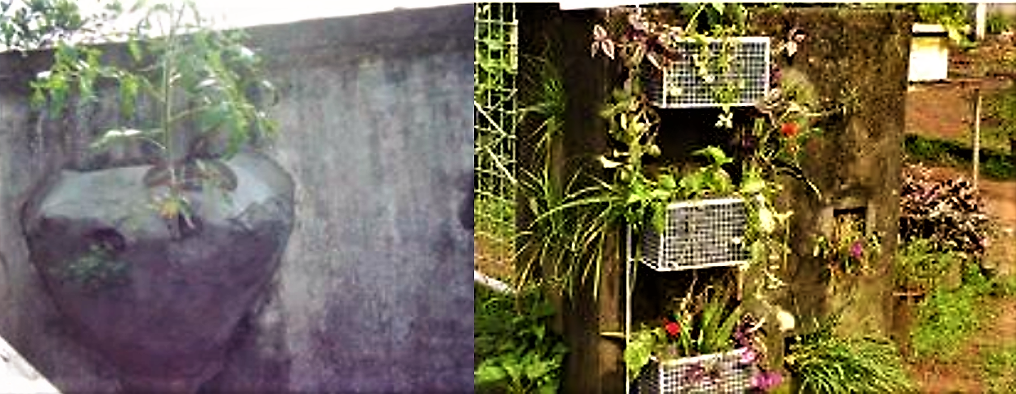
To make sure plants do grow well on vertical surfaces regular water and nutrient supply needs to be ensured. Irrigation techniques like bottle irrigation (see also irrigation) or regular watering with watering cans and alike can be used. Essential plant nutrients like Nitrogen, Phosphorus and Potassium should be applied according to the needs of the plants and in similar amounts as removed from the growing medium with the harvest. A good solution to do this is by making use of compost, vermicompost, terra preta compost and/or human urine or other organic fertiliser sources (see also chapters on urine use small- and large-scale, use of compost). The use of treated or partly treated greywater and reclaimed water can also be a cost effective alternative water and nutrient source, particularly in water scarce areas.
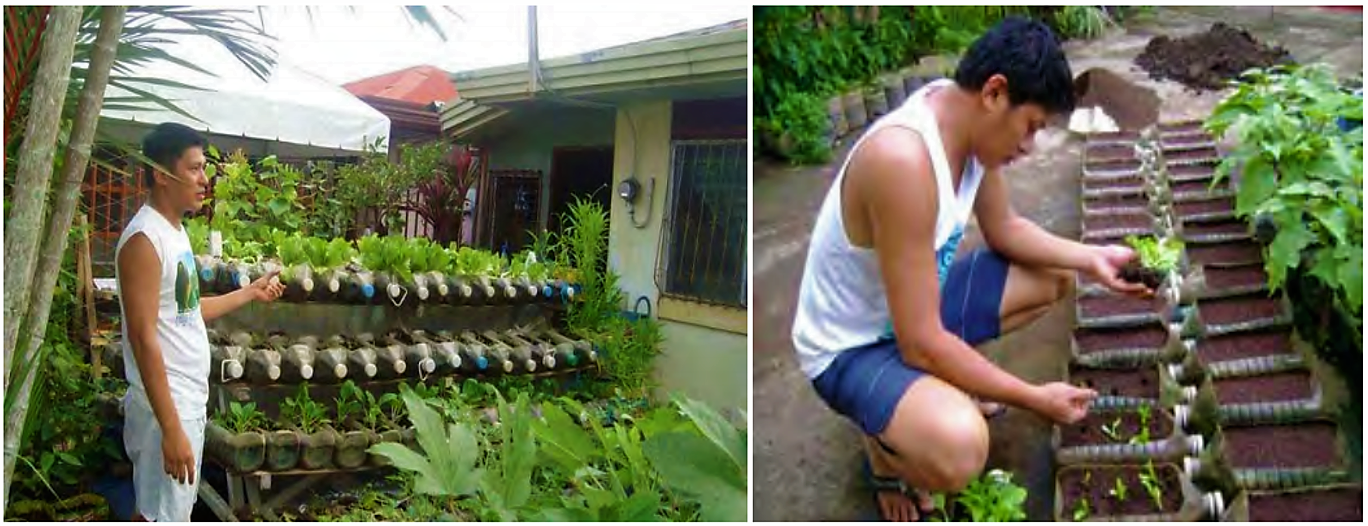
Vertical gardening is an excellent opportunity of growing food in areas where space is limited, particularly in densely populated urban areas. The different vertical garden technologies are an effective, simple and sustainable method of enhancing food security for urban communities, slum dwellers and other communities where agricultural production areas are limited. Most solutions can easily be implemented with locally available material at low cost while it offers a livelihood opportunity at the same time and contributes to the local food security situation.
Small Spaces, Big Returns
Growing vegetables in containers can improve diets and raise incomes for urban residents in the Philippines.
AVRDC (2011): Small Spaces, Big Returns. Shanhua, Tainan: AVRDC - The World Vegetable Center URL [Visita: 08.05.2019]Greywater use in peri-urban households in Kitgum, Uganda. Kampala, Uganda
This study was undertaken within the ROSA project (Resource oriented Sanitation concepts in peri‐urban areas in Africa) in order to understand greywater characteristics and to demonstrate a low cost reuse option involving direct application of untreated greywater to small so called “greywater towers” at household level in peri‐urban settlements in Kitgum Town Council.
KULABAKO, R. ; KINOBE, J. ; MUJUNGA, J. ; OLWENYI, S. ; SLEYTR, K. (2009): Greywater use in peri-urban households in Kitgum, Uganda. Kampala, Uganda. Entradas: Sustainable Sanitation Practice: Volume 1 , 16-24 . URL [Visita: 19.05.2010]Review of UPA activities in Gampaha, Sri Lanka: Lessons Learned
Presentation on urban agriculture activities in the City of Gampaha, Sri Lanka, including plenty of pictures on different vertical garden technologies implemented.
RANASINGHE, T. (2007): Review of UPA activities in Gampaha, Sri Lanka: Lessons Learned. Entradas: Proceedings of the RUAF CFF Regional Advisory Board Meeting.:Box 5.4 Vertical gardens in Gaberone, Botswana
Short description on a container gardening system for dry areas based on walls with built-in growth boxes made of hollow concrete blocks and developed by a Swedish horticulturist in Botswana.
WINBLAD, U. SIMPSON-HERBERT, M. (2004): Box 5.4 Vertical gardens in Gaberone, Botswana. Entradas: WINBLAD, U. ; SIMPSON-HERBERT, M. ; (2004): Ecological Sanitation - revised and enlarged edition. (pdf presentation). Sweden: 83. URL [Visita: 08.05.2019]Container Gardening – A Way of Growing Vegetables in the City. Paper presented at the Urban Vegetable Gardening Seminar
Paper on container gardening in Cagayan de Oro (Philippines) as a way of growing vegetables in urban areas.
DEVEZA, K. HOLMER, R. (2002): Container Gardening – A Way of Growing Vegetables in the City. Paper presented at the Urban Vegetable Gardening Seminar. Cagayan de Oro City, Philippines: Sundayag Sa Amihanang Mindanao Trade Expo URL [Visita: 08.05.2019]Greywater use in peri-urban households in Kitgum, Uganda. Kampala, Uganda
This study was undertaken within the ROSA project (Resource oriented Sanitation concepts in peri‐urban areas in Africa) in order to understand greywater characteristics and to demonstrate a low cost reuse option involving direct application of untreated greywater to small so called “greywater towers” at household level in peri‐urban settlements in Kitgum Town Council.
KULABAKO, R. ; KINOBE, J. ; MUJUNGA, J. ; OLWENYI, S. ; SLEYTR, K. (2009): Greywater use in peri-urban households in Kitgum, Uganda. Kampala, Uganda. Entradas: Sustainable Sanitation Practice: Volume 1 , 16-24 . URL [Visita: 19.05.2010]Re-use of Greywater for Agricultural Irrigation
Study on the use of greywater for agricultural irrigation in the South African context with special focus on comparing the irrigation of plants with nutrient solution, greywater and tap water.
SALUKAZANA, L. JACKSON, S. RODDA, N. SMITH, M. GOUNDEN, T. MACLEOD, N. BUCKLEY, C. (n.y): Re-use of Greywater for Agricultural Irrigation. Kwazulu-Natal: University of Kwazulu-Natal URL [Visita: 08.05.2019]Vertical and verdant, living wall systems sprout on two buildings, in Paris and Vancouver
Short article on living walls constructed in Vancouver and Paris.
GONCHAR, J. (2010): Vertical and verdant, living wall systems sprout on two buildings, in Paris and Vancouver. Entradas: Architectural Records: URL [Visita: 19.05.2010]Greywater Management in Low and Middle-Income Countries, Review of Different Treatment Systems for Households or Neighbourhoods
This report compiles international experience in greywater management on household and neighbourhood level in low and middle-income countries. The documented systems, which vary significantly in terms of complexity, performance and costs, range from simple systems for single-house applications (e.g. local infiltration or garden irrigation) to rather complex treatment trains for neighbourhoods (e.g. series of vertical and horizontal-flow planted soil filters).
MOREL, A. DIENER, S. (2006): Greywater Management in Low and Middle-Income Countries, Review of Different Treatment Systems for Households or Neighbourhoods. (= SANDEC Report No. 14/06 ). Duebendorf: Swiss Federal Institute of Aquatic Science (EAWAG), Department of Water and Sanitation in Developing Countries (SANDEC) URL [Visita: 27.05.2019]Review of UPA activities in Gampaha, Sri Lanka: Lessons Learned
Presentation on urban agriculture activities in the City of Gampaha, Sri Lanka, including plenty of pictures on different vertical garden technologies implemented.
RANASINGHE, T. (2007): Review of UPA activities in Gampaha, Sri Lanka: Lessons Learned. Entradas: Proceedings of the RUAF CFF Regional Advisory Board Meeting.:Small Spaces, Big Returns
Growing vegetables in containers can improve diets and raise incomes for urban residents in the Philippines.
AVRDC (2011): Small Spaces, Big Returns. Shanhua, Tainan: AVRDC - The World Vegetable Center URL [Visita: 08.05.2019]Greywater use in peri-urban households in Kitgum, Uganda. Kampala, Uganda
This study was undertaken within the ROSA project (Resource oriented Sanitation concepts in peri‐urban areas in Africa) in order to understand greywater characteristics and to demonstrate a low cost reuse option involving direct application of untreated greywater to small so called “greywater towers” at household level in peri‐urban settlements in Kitgum Town Council.
KULABAKO, R. ; KINOBE, J. ; MUJUNGA, J. ; OLWENYI, S. ; SLEYTR, K. (2009): Greywater use in peri-urban households in Kitgum, Uganda. Kampala, Uganda. Entradas: Sustainable Sanitation Practice: Volume 1 , 16-24 . URL [Visita: 19.05.2010]A garden in a Sack: Experiences in Kibera, Nairobi
Article in the RUAF Urban Agriculture Magazine on gardening activities in the Kibera slum, Nairobi, Kenya
PASCAL, P. ; MWENDE, E. (2009): A garden in a Sack: Experiences in Kibera, Nairobi. Entradas: Urban Agriculture Magazine: Volume 21 , 38-40. URL [Visita: 22.05.2012]Small-scale Systems for Greywater Reuse and Disposal
This work aimed at evaluating two systems – vertical gardens and mulch beds – that were implemented as an alternative to current greywater disposal practices in low-income households in Ouagadougou, Burkina Faso. Literature on greywater reuse and disposal systems and risks connected with greywater irrigation were studied as well as relevant site-specific parameters. Experiments were carried out on two new vertical gardens in addition to soil analyses, interviews and observations in households where vertical gardens and mulch beds had been in use for several months.
EKLUND, O.C. TEGELBERG, L. (2010): Small-scale Systems for Greywater Reuse and Disposal. Uppsala: Department of Energy and Technology, Swedish University of Agricultural sciences URL [Visita: 06.01.2011]Introduction to Greywater Management
The report gives a comprehensive description of the main components in successful greywater management. Examples as well as recommendations are given for designing and dimensioning treatment systems.
RIDDERSTOLPE, P. (2004): Introduction to Greywater Management. (= EcoSanRes Publication Series, Report 2004-4 ). Stockholm: Stockholm Environment Institute, EcoSanRes Programme URL [Visita: 19.05.2010]Box 5.4 Vertical gardens in Gaberone, Botswana
Short description on a container gardening system for dry areas based on walls with built-in growth boxes made of hollow concrete blocks and developed by a Swedish horticulturist in Botswana.
WINBLAD, U. SIMPSON-HERBERT, M. (2004): Box 5.4 Vertical gardens in Gaberone, Botswana. Entradas: WINBLAD, U. ; SIMPSON-HERBERT, M. ; (2004): Ecological Sanitation - revised and enlarged edition. (pdf presentation). Sweden: 83. URL [Visita: 08.05.2019]Review of UPA activities in Gampaha, Sri Lanka: Lessons Learned
Presentation on urban agriculture activities in the City of Gampaha, Sri Lanka, including plenty of pictures on different vertical garden technologies implemented.
RANASINGHE, T. (2007): Review of UPA activities in Gampaha, Sri Lanka: Lessons Learned. Entradas: Proceedings of the RUAF CFF Regional Advisory Board Meeting.:Introduction to Greywater Management
The report gives a comprehensive description of the main components in successful greywater management. Examples as well as recommendations are given for designing and dimensioning treatment systems.
RIDDERSTOLPE, P. (2004): Introduction to Greywater Management. (= EcoSanRes Publication Series, Report 2004-4 ). Stockholm: Stockholm Environment Institute, EcoSanRes Programme URL [Visita: 19.05.2010]Vertical Garden Images
A collection of vertical garden images.
Singapore's vertical farm
A short video documentation on Sky Greens, a vertical garden farming project in Singapore.


